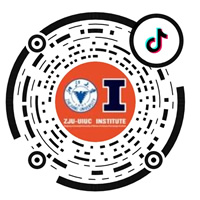XU Xinyi
ZJUI Doctoral Students
Research interests: Remote Sensing, Broadband Single-pixel Imaging, Statistical Signal Processing and Neuromorphic Computing
Published 2 SCI papers and 4 EI papers in top journals as first author, and co-authored 2 SCI papers
Likes dancing, drawing and animals
Pioneering and innovating to assiduously expand the boundaries of knowledge
XU Xinyi graduated from Huazhong University of Science and Technology with a bachelor’s degree in electronic information engineering. With her enthusiasm for scientific research and her hard-working inquiring spirit, she has participated in a number of scientific research projects and achieved some preliminary results: she has authored 8 papers in top journals.
▲ First-authored papers in IEEE Transactions on Geoscience and Remote Sensing
IEEE Transactions on Geoscience and Remote Sensing, an international authoritative journal in the field of remote sensing, published the latest research result by XU Xinyi entitled “Parametric Magnetotelluric Impedance Tensor Estimation”. In the paper, she proposed a parametric electromagnetic transfer function estimation method based on system identification. Her work “Neuromorphic device based on silicon nanosheets”, which she co-authored with WANG Chenhao,was published in Nature Communication. The main content of this work is the study of neuromorphic devices based on silicon nanosheets.
▲ Flow chart of parametric transfer function estimation based on system identification
Magnetotelluric (MT) is an important geophysical tool to study the electrical structure of the Earth's interior using natural electromagnetic fields as the field source. However, traditional methods for estimating electromagnetic transfer functions are usually nonparametric, and the signal-to-noise ratio of the measured electromagnetic field directly determines the accuracy of the estimated impedance tensor, which is prone to produce seriously biased estimates. To address this problem, XU Xinyi, under the guidance of ZJUI researcher and Assist prof. Mark Butala, proposed a new parametric transfer function estimation method that can consider the effects of impedance at different frequencies on the transfer function model synergistically, and facilitate the screening and processing of Electromagnetic data under complex noise contamination. By applying the method to several measured MT datasets published by USArray, they have verified that the parametric method can provide more accurate estimates of long-period data with short training data lengths. In addition, they also validated the robustness of the method with other experiments in a conference paper under the journal, and demonstrated that the parametric system identification based on the Output Error model is a practical, effective, and long-term method for estimating the MT transfer function, which can reduce the time cost of EM data acquisition, improve the efficiency of magnetotelluric data utilization, and has positive significance for oil and gas, geothermal and groundwater, mineral resources exploration and seismic and volcanic monitoring.
▲ Comparison of the residuals of the predicted output electric field and the measured electric field. (V1, V2 represent different validation data segments)
▲ Nature Communication published the co-first-authored results
Her work "Neuromorphic device based on silicon nanosheets", which she co-authored with WANG Chenhao from the State Key Laboratory of Silicon Materials, Zhejiang University, was published in Nature Communication (impact factor 17.694). The main content of this work is the study of neuromorphic devices based on silicon nanosheets. Neuromorphic computing is a brain-inspired approach with the advantages of high parallelism and ultra-low power consumption and is an ideal way to break the limitations of traditional computers architecture and achieve a new generation of artificial intelligence. Neuromorphic devices, on the other hand, are the hardware carriers for implementing neuromorphic computing and are the key to building neuromorphic chips. In this project, they prepared and tested a silicon nanosheet device, and then established a neurosynaptic model based on the relationship between the vinput oltage and output current at both ends of the device to simulate a spiking neural network architecture for handwritten digit recognition, demonstrating the feasibility of silicon nanosheet devices as neuromorphic devices, which is expected to improve the rapidly growing urgent need for efficient and high-speed computing to a certain extent.
Whether it is the vast and invisible magnetotelluric or microscopic and precise neuromorphic devices, as long as she is involved in the projects, she always upholds the original intention of bringing some convenience to people’s lives and does her best to actively think and strive to be excellent, trying to make big excitement and achieve big leaps through her small steps.
Collecting widely all good qualities with dual instructors and dual platforms
In addition to having Assist Prof. Mark Butala of ZJUI as her PhD supervisor, XU Xinyi also has Prof. XU Yang from the School of Micro-Nano Electronics of Zhejiang University as her co-supervisor. Her two supervisors have very different styles, but both provide her with more ideas, rich opportunities and a broad platform for her research path.
▲ XU Xinyi's two instructors (left: Assist Prof. Mark Butala, right: Prof. XU Yang)
▲ Mid-term defense site
" 'It's our work. We are working together.' is what Assist Prof. Mark Butala always says to me," XU Xinyi shared with us. "He seems to be ready to support me no matter what difficulties I encounter." Even if Assist Prof. Mark Butala did not request it, XU Xinyi would take the initiative to communicate and discuss with him once a week, and when there was no progress in her research, she would share her recent study with Assist Prof. Mark Butala like a friend. He formulated targeted improvement plans according to the graduation requirements, repeatedly helped XU Xinyi revise the paper word for word, shared his writing experience and taught the key points of writing. More often than not, Assist Prof. Mark Butala was like an emotional first-aid kit that patiently listened to XU Xinyi's worries and anxieties, and it was his deep listening, affirmation and understanding that gave XU Xinyi great motivation to move forward.
▲ Group photo with Assist Prof. Mark Butala
Assist Prof. Mark Butala is always smiling, but what XU Xinyi did when she wrote her first conference paper made Assist Prof. Mark Butala change his usual easy-going manner and become stern. " There is a paragraph in the paper about the data set, and I went to the relevant website to add the original introduction to the paper with slight modifications. After reading the paper, Assist Prof. Mark Butala sent me email seriously, explaining in detail the issue of "plagiarize" and academic integrity, which was extremely serious and angry." Looking back on this email three years ago, XU Xinyi can still remember it vividly, because usually, even if the research progress was slow and backward, or she was misguided into a wrong research direction, Assist Prof. Mark Butala did not say a serious word, but only encourage her and find the problem together with her. This angry email fully demonstrated that Assist Prof. Mark Butala’s zero tolerance for plagiarism and high requirements for academic rigor.
Another co-supervisor, Prof. XU Yang, has a relatively large research team and therefore gives XU Xinyi a different kind of research atmosphere. Prof. XU Yang has designed a system of group meeting and forums, inviting distinguished scholars in related fields to give presentations every week, and has close cooperation with many professors to build a good platform for students. In Prof. XU Yang's group, XU Xinyi is no longer the seasoned one who needs to carry the burden but can seek advice from her seniors and learn from them. At the same time, through cross-collaboration with outstanding students in other labs, the efficiency of research output has been improved.
▲XU Xinyang’s presentations at international conferences
Advancing with indomitable will to go forward in the ordinary
▲ Dance Performance in New Year Party
When XU Xinyi received the interview invitation, she kept saying that she was a very ordinary person. But in the eyes of her supervisors, she is indeed an excellent role model of building on the ordinary and moving forward. “Xinyi is a senior PhD student in my group. She has exhibited self-determination, perseverance, and true grit throughout her graduate studies, developing with aplomb as an independent researcher. She undertakes her research in a serious and methodical fashion, delivering contributions to several projects.” Assist Prof. Mark Butala praised XU Xinyi, his beloved student, “I believe Xinyi embodies many of the qualities we strive towards in ZJUI: ability and desire to undertake challenging interdisciplinary research and the courage to work closely with others in initially unfamiliar domains.”
▲ At the Dancing Room of the Residential College, International Campus
Talking about some of her thoughts on scientific research, XU Xinyi said, "I think we must have a clear purpose and plan to do research." In terms of "purpose," she indicates that we should always focus on the value and meaning of the work at hand, "I often think about the 'so, why' question, i.e., 'This method works, but then what? Why should others use this method?'" This is a progressive way of asking yourself questions that help you analyze the situation and clarify your thinking. As the name implies, "planning" is the idea that clear steps and timelines for completion can help drive scientific research progress more efficiently. She said, "In addition to developing a plan and a timeline for each step, it is important to take a more macro perspective and think about whether the current topic is in step with the general direction of the research you tend to do or the annual plan, and if you can integrate the general direction of the plan with the sub-topics and execute it effectively according to the plan."
If scientific research encounters bottlenecks and difficulties, XU Xinyi prefers to solve them through communication and discussion, "When encountering difficulties, I think we must discuss them with our supervisors in time, not to chase a dead end, and of course never give up." Her diligent thinking, willingness to communicate, and good communication style also benefits from the diverse and international atmosphere of ZJUI and the International Campus. "Studying in such an environment, my biggest feeling is that it is free and unconstrained, pluralistic and not dull. There are many foreign professors at ZJUI, and you can often see faculty members and students discussing together in the café or on the road, so students have a lot less fear and more trust in their instructors. I think only the relationship of mutual trust and mutual respect can lead to closer cooperation, which in turn leads to better scientific research results."







